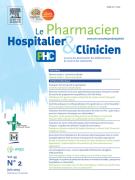Clinical pharmacist assisted thromboprophylactic optimization in general surgical patients - 05/02/16
Évaluation des pratiques professionnelles et pharmaciens cliniciens en Inde
 , K.K. Ajmal a, T.N.K. Suriyaprakash b, S. Anusree a
, K.K. Ajmal a, T.N.K. Suriyaprakash b, S. Anusree aCet article a été publié dans un numéro de la revue, cliquez ici pour y accéder
Summary |
Introduction |
Practice of prophylaxis against venous thromboembolism (VTE) following surgical procedures has been in the scenario for about half a century. Despite the surging evidence regarding the clinical and economic efficacy, the practice remains underutilized. The study was aimed at optimizing the prophylactic practices for prevention of VTE in the general surgical patients in a tertiary care hospital using a pharmacist assisted multi-strategy intervention.
Methods |
The prospective quasi-experimental study was conducted in general surgical department of a tertiary care hospital in Kerala. The initial audit phase was targeted at assessing the prevailing prophylactic practices and its adequacy in relation to American College of Chest Physicians (ACCP) guidelines. This was followed by an educational phase where physicians were provided the feedback and institutional protocol. The third phase involved intervention through patient risk stratification and prophylactic recommendation by pharmacist concomitantly with reaudit.
Result |
The overall non-compliance to the therapy decreased from 52% in the control phase to 20% in the intervention phase with P=0.0009. The partial compliance to therapy reduced from 40% in the control phase to 32% in the intervention phase with P=0.4047. Total compliance to therapy increased from 8% in the control to 48% in the intervention stage and the difference was found to be significant with P<0.0001.
Discussion |
The study was effective in increasing the overall compliance to the ACCP 9th guidelines by 40% and the average duration by 1.61 days. Clinical pharmacist assisted multi-strategy interventions were effective in enhancing the appropriateness of the prophylaxis as per the ACCP recommendations.
Le texte complet de cet article est disponible en PDF.Résumé |
Introduction |
Les recommandations concernant la prévention du thrombo-embolisme veineux (VTE) postopératoire datent d’un demi-siècle. Malgré l’évidence de l’efficacité clinique et économique, les recommandations restent encore parfois peu ou mal utilisées. L’étude a visé à optimiser les pratiques de prévention du VTE chez les patients hospitalisés en chirurgie générale dans un hôpital de soin possédant des pharmaciens cliniciens.
Méthodes |
L’étude quasi expérimentale éventuelle a été conduite dans le département de chirurgie générale d’un hôpital du Kerala. La phase initiale a été un audit des pratiques prophylactiques existantes et leur adéquation avec les directives cliniques de l’American College of Chest Physicians (ACCP). Ceci a été suivi par une phase éducative où les pharmaciens cliniciens ont présenté le résultat d’audit aux médecins avec un protocole institutionnel. La troisième phase a impliqué une intervention des pharmaciens selon le profil de risque du patient avec un rappel de la recommandation prophylactique et dans la foulée un nouvel audit.
Résultats |
Le non-respect global à la thérapie a diminué de 52 % dans la phase de contrôle à 20 % dans la phase d’intervention (p=0,0009). La conformité partielle aux directives cliniques a été réduite de 40 % pour la phase de contrôle jusqu’à 32 % pour la phase d’intervention (p=0,4047). La conformité totale aux directives cliniques s’est accrue significativement de 8 % pour le contrôle jusqu’à 48 % pour l’étape d’intervention (p<0,0001).
Discussion–conclusion |
La stratégie utilisée s’est avérée efficace pour améliorer la conformité globale aux 9es directives ACCP (+40 %) et la durée moyenne à 1,61jours. Les interventions du pharmacien clinicien se sont avérées efficaces pour assurer le respect des directives cliniques de l’ACCP.
Le texte complet de cet article est disponible en PDF.Keywords : Pharmacists, Thromboembolism, Prevention and control, General surgery, Anticoagulants
Mots clés : Pharmaciens, Thromboembolisme, Prévention, Audit, Chirurgie générale, Anticoagulants
Plan
Bienvenue sur EM-consulte, la référence des professionnels de santé.
L’accès au texte intégral de cet article nécessite un abonnement.
Déjà abonné à cette revue ?

